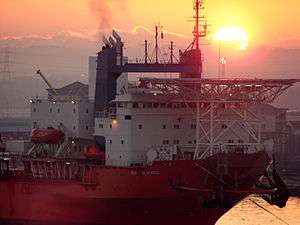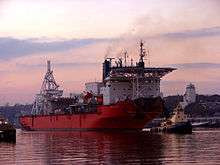Mafuta (ship)
The Mafuta is a diamond-mining ship owned and operated by De Beers in the western coast of South Africa.[11] Built in 1983 as Dock Express 20 for Dock Express Shipping (later Dockwise), the semi-submersible multirole heavy lift vessel was converted to the world's largest cable layer in 1993.[9] In 2005 she was purchased by De Beers, converted to a subsea diamond mining ship by A&P Tyne over the course of 11 months. The ship's new name, Peace in Africa, may have implied that it was providing an alternative to blood diamonds.[6][12] In 2013, still under ownership of De Beers Marine Namibia, the vessel was renamed to MV Mafuta.
 Peace in Africa during the 2006 refitting on the Tyne. | |
| History | |
|---|---|
| Name: |
|
| Owner: |
|
| Port of registry: |
|
| Builder: | Verolme Shipyard Heusden, Netherlands[3] |
| Yard number: | 994[3] |
| Laid down: | 1982[4] |
| Launched: | 12 November 1982[4] |
| Completed: | May 1983[4] |
| Identification: | |
| Status: | In service[5] |
| General characteristics (as built)[3] | |
| Type: | Heavy lift ship |
| Tonnage: | |
| Length: | |
| Beam: | 24.20 m (79.4 ft) |
| Draught: | 8.9 m (29.2 ft) |
| Depth: | 15 m (49.2 ft) |
| Main engines: | 2 × Stork-Werkspoor 6TM410[4] (2 × 3,128 kW[7]) |
| Auxiliary engines: | 2 × 600 kW |
| Propulsion: |
|
| Speed: | 16 kn (30 km/h; 18 mph) |
| Capacity: | 2,576 m2 (27,730 sq ft) cargo deck |
| Crew: | 24 |
| General characteristics (1993)[8] | |
| Type: | Cable ship |
| Displacement: | 21,731 tons |
| Draught: | 8.79 m (28.8 ft) |
| Propulsion: | Azimuth thrusters (3 × 1,325 kW)[7] |
| Speed: | 12.5 knots (23.2 km/h; 14.4 mph) |
| Range: | 20,500 nautical miles (38,000 km; 23,600 mi) |
| Capacity: | 10,000 tons of cable, 100 repeaters |
| Crew: | 85[9] |
| General characteristics (2007)[5] | |
| Type: | Dredger |
| Tonnage: | |
| Crew: | 68[10] |
Construction
Then named Dock Express 20, the ship's keel was laid in 1982 in the Netherlands at Verolme Shipyard Heusden and it was launched the following year. Originally a heavy lift ship, it has an overall length of 169.52 metres (556.2 ft). In terms of width, the ship has a beam of 24.20 metres (79.4 ft). The height from the top of the keel to the main deck, called the moulded depth, is 15 metres (49 ft).[13]
The ship's gross tonnage, a measure of the volume of all its enclosed spaces, is 14,793. Its net tonnage, which measures the volume of the cargo spaces, is 4,437. Its total carrying capacity in terms of weight, is 14,617 long tons deadweight (DWT), the equivalent of approximately 300 adult male sperm whales.[14]
Dock Express 20 was powered by two Stork-Werkspoor 6TM410 four-stroke medium-speed marine diesel engines of 3,128 kW (4,195 hp) apiece. Each engine powered an independent controllable-pitch propeller. This main propulsion system was able to move the ship at 16 knots (30 km/h; 18 mph). For harbour-maneuvering, the vessel was also fitted with a 625 kW bow thruster. In addition the ship has two 600-kilowatt (800 hp) auxiliary generators to provide shipboard electrical power. When the Dock Express 20 was converted to a dynamically positioned cable ship, she was refitted with three 1,325 kilowatts (1,777 hp) azimuth thrusters to serve as its main propulsion.
Dock Express 20 was originally built to house 24 crewmembers, but that number was more than tripled in the 1993 conversion. In 2007 the ship was converted again to work as a dredger, increasing the gross tonnage to 15,854, and the deadweight tonnage to 7,935 long tons.
Career
Early career
Dock Express 20 was built for use in the offshore oil industry.[15]
The Dock Express 20 was involved in the sinking of the tugboat Terminator some 20 miles (32 km) off the coast of California on 27 January 1992. Following an engine failure the heavy seas pushed the tugboat against one of the protruding stern sponsons of the heavy lift vessel, causing enough damage to sink the vessel in 25 minutes. The crew evacuated to a life raft and was picked up by another ship.[16]
Cable layer
The ship was converted to a cable layer by Tyco Submarine Systems, and worked under charter to this company.[15]
Dock Express 20 is pictured on the Russian postcard commemorating a submarine cable between Denmark and Russia. The ship laid a 1,200 kilometres (750 mi) cable from Copenhagen to Kingiseppe, which connects via microwave to Moscow and St. Petersburg.[17]
Dock Express 20 was one of three ships that worked on the northern section of the Pacific Crossing-1 (PC-1) system cable, linking the United States and Japan.[18] It also laid telecommunications cable between San Francisco and Guam.[19]
Diamond mining

As of 2011, Peace in Africa was operating off the coast of Namaqualand in underwater diamond mining.[20] Its ML3 mining license, according to a 2007 report, began appx. 5 km offshore of Kleinzee, running north to Alexander Bay, Northern Cape, and extended seaward for 17–32 km. Prior to 2007, the ship had operated in the neighboring Atlantic 1 licence area in Namibia, which contained higher gem quality diamonds.[21]
The dredging equipment aboard Peace in Africa includes a 240-ton crawler, described as "a large undersea tracked mining tool" connected to the ship by a 655 mm internal diameter rubber hose, and a "diamond recovery treatment plant" built by Bateman Engineering.[20][22] The dredge has a suction capacity of about 10,000 cubic meters of water and gravel per hour, resulting in about 250 tons of material to be processed for diamonds.[21] The anticipated yield is approximately 60 diamonds per hour, or roughly 240,000 carats annually.[22]
Peace in Africa was the second largest ship registered in South Africa, and worked on a continuous, round-the-clock basis, as of 2007. Its mining operation was projected to have a lifespan of nineteen years.[21]
As of 2006, De Beers Marine Namibia was operating five mining vessels, including Peace in Africa.[11]
Peace in Africa appeared in a 2009 episode of the Discovery Channel's documentary series Mighty Ships.
In 2013, still under ownership of De Beers Marine Namibia the vessel was renamed to MV Mafuta.
References
- Dockwise. Tussen Hoek en Stad. Retrieved 2011-08-30.
- "Dock Express 20 (270429)". Port State Information Exchange. United States Coast Guard. Retrieved 20 May 2013.
- NB994 Dock Express 20 Archived 4 October 2011 at the Wayback Machine. Shipyard De Hoop. Retrieved 2011-08-30.
- DOCK EXPRESS 20 (Google Cache). 10 June 2005.
- "Peace in Africa (8125064)". Equasis. French Ministry for Transport. Retrieved 30 August 2011.
- A&P wins Conversion Contract. MarineLink.com, 20 July 2005. Retrieved 2011-08-30.
- Sea State Alarm trial on cable ship Dock Express 20. Breeman Engineering and Services bv. Retrieved 2011-08-30.
- General features of optical fibre submarine cable systems Archived 7 October 2011 at the Wayback Machine. ITU-T Recommendation G.971, 04/2000. Retrieved 2011-08-30.
- Brown, Nicholas. Dutch ships lay Tyco cable. Seacoastonline.com, 21 June 2002. Retrieved 2011-08-30.
- Sharda (4 August 2011). "Mining Ship MV Peace in Africa : The Diamond Hunter". Marine Insight. Retrieved 29 August 2011.
- Creamer Media Reporter (4 May 2007). "New mining vessel boasts latest technology". Creamer Media's Mining Weekly.com. Retrieved 29 August 2011.
- Choo, Yoo Sang; Edelson, David N. (2008). Marine Operations Specialty Symposium. Research Publishing Services.
- "International Convention on Tonnage Measurement of Ships, 1969". International Conventions. Admiralty and Maritime Law Guide. 23 June 1969. Retrieved 1 September 2011.
- Shirihai, H. & Jarrett, B. (2006). Whales Dolphins and Other Marine Mammals of the World. Princeton: Princeton Univ. Press. pp. 21–24. ISBN 978-0-691-12757-6.
- "Dock Express 20 - IMO 8125064". Shipspotting.com. 2011. Retrieved 30 August 2011.
- US Coast Guard Marine Casualty investigation MC93011836 and Marine Violation investigation MV92003258.
- Glover, Bill (2005). "History of the Atlantic Cable & Undersea Communications from the first submarine cable of 1850 to the worldwide fibre optic network Cable Stamps - ANZCAN, SCOTICECAN, Bermuda-Tortola, Denmark-Russia, Isle of Man-UK". History of the Atlantic Cable & Undersea Communications from the first submarine cable of 1850 to the worldwide fibre optic network. Retrieved 30 August 2011.
- "Tyco Submarine Systems Provides the World's Most Advanced Transoceanic Network 3-Months Ahead of Contract Schedule - Company Business and Marketing". FindArticles / Technology / Cambridge Telcom Report. 3 January 2000. Retrieved 30 August 2011.
- Brugghe, Patrick (2000). "A metocean case study, How satellite measurements of wave heights can improve the decision-making process on board a ship carrying out a mission sensitive to sea conditions". Retrieved 30 August 2011.
- Van de Velde, Marc. "Marine diamond mining vessel "Peace in Africa"". The Art of Dredging. Retrieved 29 August 2011.
- "Debmarines sea diamonds success". Cape Business News. August 2007. Archived from the original on 28 September 2011. Retrieved 31 August 2011.
- Kruger, Tessa (21 April 2007). "De Beers launches its first South African marine diamond mining vessel". Mineweb.com. Retrieved 29 August 2011.